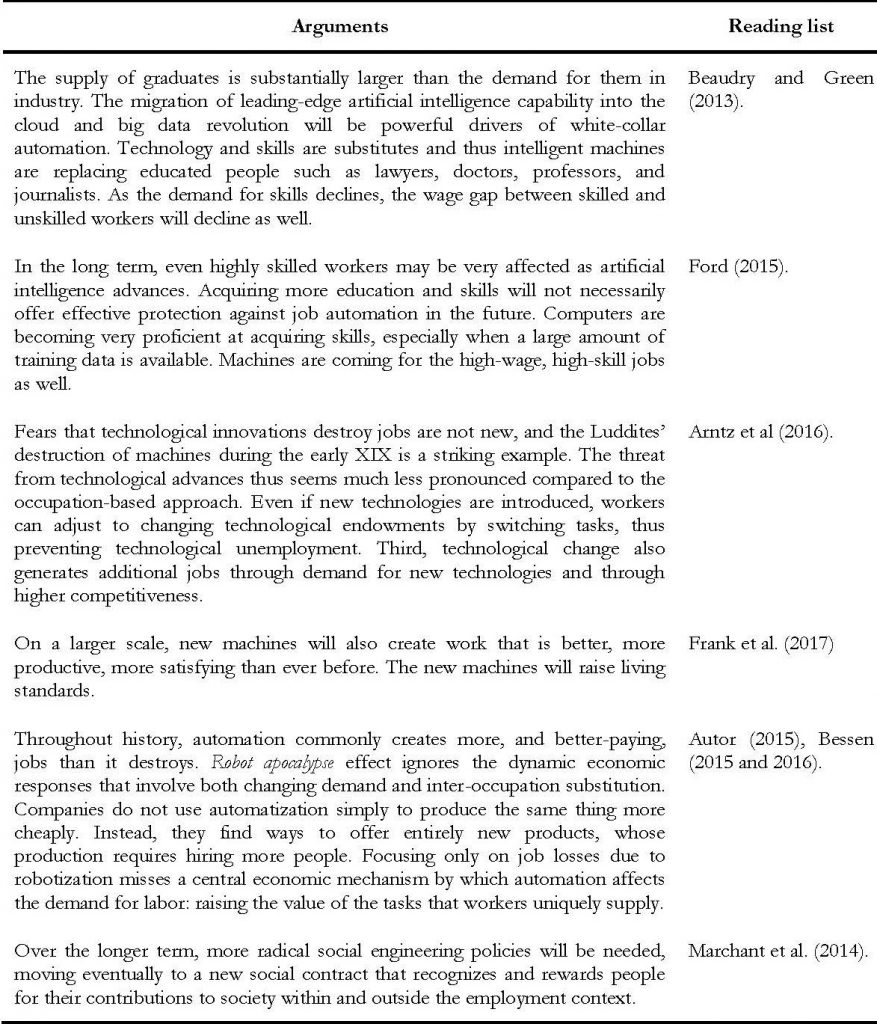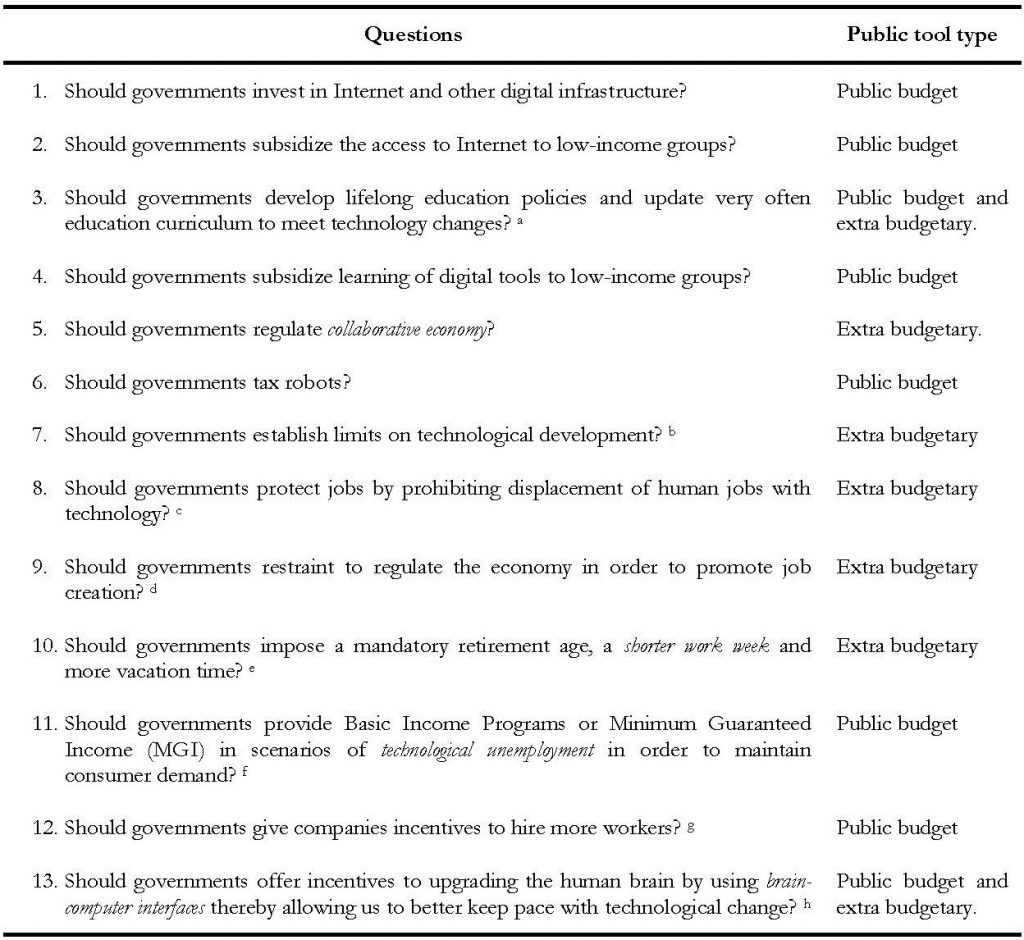The impact of digital revolution on social fairness: four seminar’s topics
1. INTRODUCTION
The emergence of the Internet and smartphones, the connection between the two phenomena and the progress of digitization have transformed both our personal lives and the way in which economic activities take place. Now we do many things differently at work, and in our leisure time in comparison to how we used to do them. The Internet has become a part of our everyday life, rather than a separate place to be[1] and some tech companies have become a big part of our lives. Looking ahead, phenomena as Big Data, Internet of Things (IoT), artificial intelligence (AI), machine learning (ML) and the advancement of robotization and mobile robotics (MR) will accelerate this transformation. Digitalization does not change economic laws[2], nor does government objectives (economic efficiency, equity, business cycle stabilization and long-term economic development). However, economic relations change and economists who study government intervention in the economy must consider this transformation in their analysis to better understand how society functions. Unequivocally we find ourselves in the middle of an information revolution and incorporating the impact of the digital revolution on public economics syllabus will result in a greater interest on the part of our students. Students who nowadays are digital natives.[3] This article outlines certain topics that could be incorporated in public economics courses in relation to equality and redistributive aspects. In connection to this specific field, I propose a set of discussion topics that can be used in seminars as well as for individual essays’ subjects. In addition, some practical aspects on how to conduct the seminar are included at the end of the paper. In particular, some details on how to organize the seminar, a sample of seminar’s instructions and tips on how to perform the presentations, as well as a suggestion on how to evaluate the seminar session are shown.
Although this article focuses on equality and redistributive aspects, it should be emphasized that much of the content of public economics syllabus should be revisited under the light of the impact of the digital revolution.[4] A new generation of students that has already entered the university is termed digital natives. This is the main reason why we propose to cover the material on equity using the format of a seminar instead of traditional lectures. This net generation is said to have been immersed in technology all their lives. People of this generation are ready to speak about their experiences on the access to ICTs and their skills on tech matters. They feel technology at the core of their lives and a seminar on this subject may contribute to get public economics closer to their learning interests.
2. COMMON TOPICS ON EQUITY AND REDISTRIBUTION IN PUBLIC ECONOMICS COURSES
On the one hand, government interventions in the economy are justified by the existence of economic inefficiencies. The analysis of inefficiencies arising from market failures occupies a relevant part in public economy manuals. But even in the event that an economically efficient outcome could be achieved after all market transactions have taken place, it may happen that the resulting outcome may be undesirable for the society due to its unfairness. This usually occurs when the initial endowments of the society's members are very unequal. Also for that reason, governments intervene in a number markets, in this case aiming to increase horizontal and vertical equity levels. As a result, all public economics courses include the analysis of topics connected to equity level and redistributive goals, including among others those shown in Table 1.
Table 1: Common topics on equity in public economics courses Source: Own elaboration.
Source: Own elaboration.
3. SOME TOPICS ON THE IMPACT OF DIGITAL REVOLUTION ON EQUITY AND REDISTRIBUTION
In this section, I propose four topics that relate to the consequences of digitalization and robotization of the economy on fairness and distributive aspects. For each topic, I point out some of the arguments to consider in the discussion and offer a set of reading lists to deliver to students.
It should be noted that the digital revolution is also significantly affecting two other services typically provided directly or indirectly by governments with an impact on equity: education and healthcare. These two topics are not covered in this article.
3.1. DOES INTERNET REDUCE INEQUALITY?
In the discussion on the equalizing power of Internet,[5] we find many arguments regarding the possible improvement of equal opportunities between nations and individuals that the diffusion of the Internet could generate. See Table 2.
Table 2: The case for the equalizing power of the Internet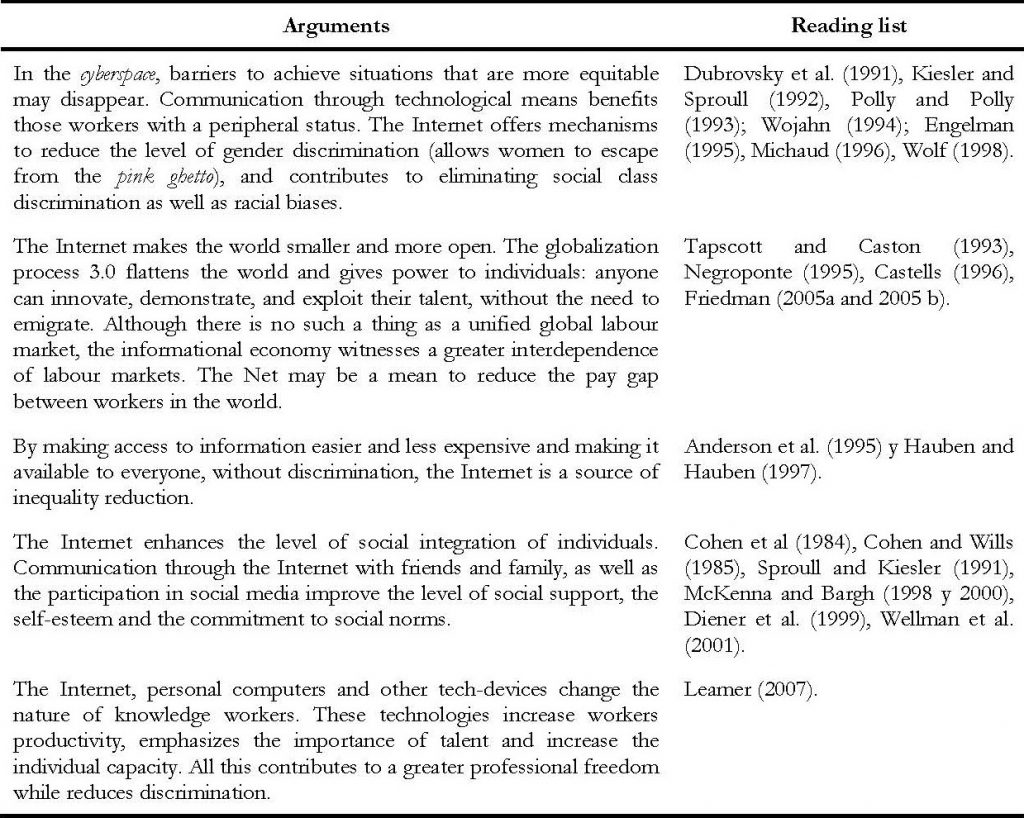 Source: own elaboration.
Source: own elaboration.
However, not all scholars are so optimistic about the impact of digital technologies on the inequality level among nations and among citizens of each country. For some, the rise of informationalism at the end of the millennium has been linked to situations of increasing inequality and higher exclusion.[6] Some pessimistic opinions about the contribution of the Internet to the level of social justice between individuals are shown in Table 3.
Table 3: The case for a negative contribution of the Internet to the level of equity Source: own elaboration.
Source: own elaboration.
3.2. HOW RELEVANT IS AND WHAT DETERMINES THE DIGITAL DIVIDE?
The access to the Internet has been developing unevenly in the world, between nations[7] and individuals. The digital revolution has transformed the lives of many, but also has left untouched the lives of many others.[8] Part of the world population misses out on the opportunities created by the Internet. This gap between the information haves and have-nots is commonly referred to as the digital gap or the digital divide.[9] Internet threatens to divide society into two classes: the information elite on the one hand and those not linked to the Net on the other. When it comes to participating in the information age this gap relates to both economies and individuals within each society.[10] This digital gap is identified with differences regarding: the availability of physical access to the Internet, the possibility of using the Net from different devices; the spatial access flexibility; or navigation skills[11]. Both, practitioners and researchers distinguish three stages in the diffusion and social impact of new technologies: the access, the effective usage and its tangible impact.[12] Regarding the main determinants of the digital gap see Table 4, and see Table 5 for empirical results.
Table 4: Main determinants of the digital gap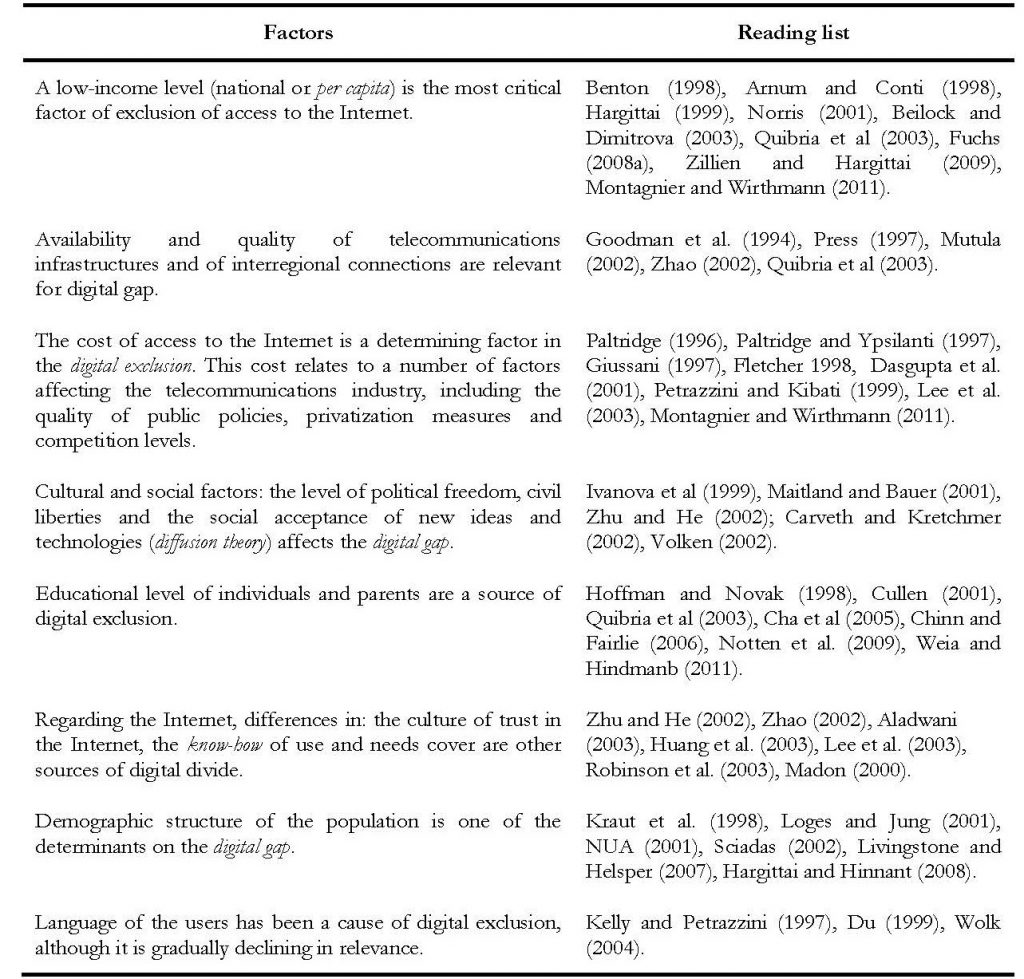
(continuation of Table 4)  Source: Prepared by the author based on Contreras (2017).
Source: Prepared by the author based on Contreras (2017).
Table 5: Empirical evidence on the digital gap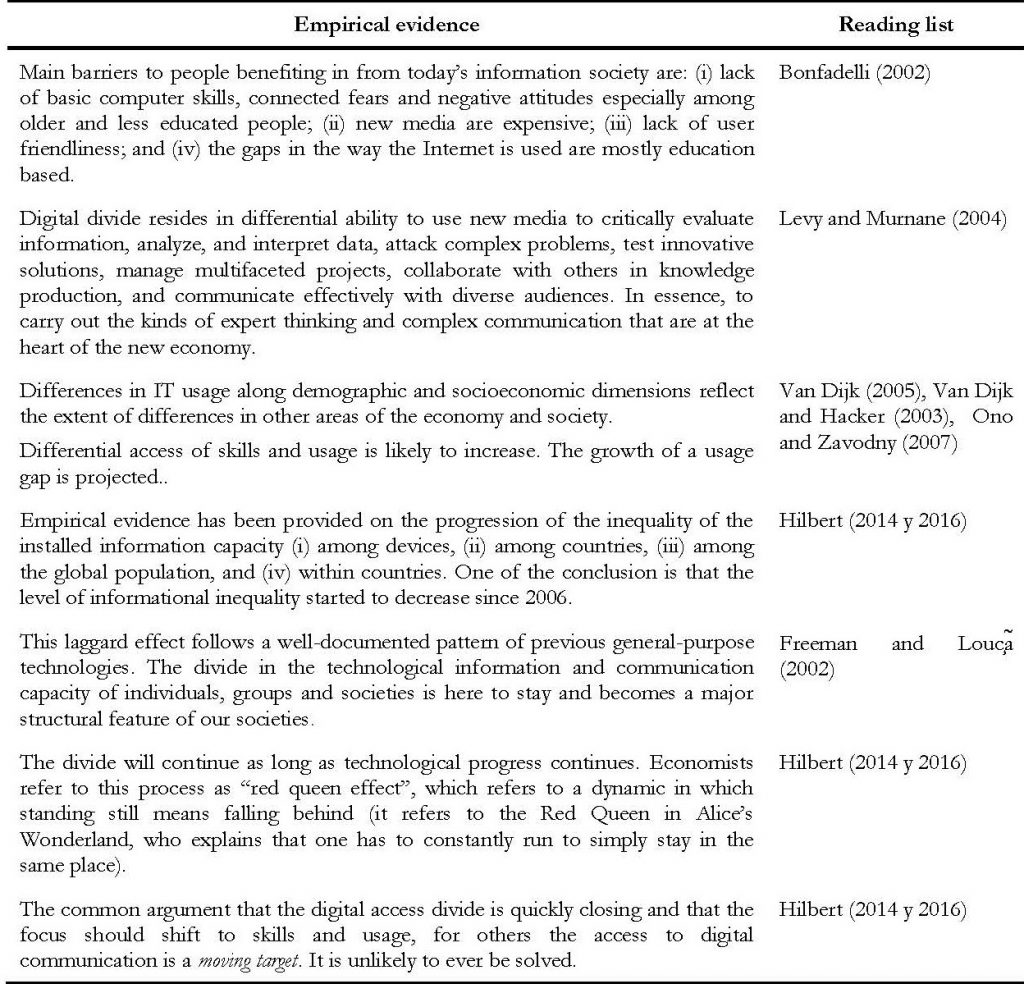 Source: Prepared by the author.
Source: Prepared by the author.
3.3. DOES SHARING ECONOMY ALTER UNFAIRNESS LEVEL?
One feature of phenomena such as Web 2.0/3.0 and social media is the relevance of sharing.[13] Sharing of goods and services has always existed, but traditionally it has taken place within the family or among agents who knew each other, and among whom there was a relationship of trust. The emergence of what has come to be called sharing economy o collaborative economy,[14] represents an important change, since it has allowed the collaboration and sharing among strangers. Something that has been feasible thanks to innovations in information technologies.[15] Individuals and companies increasingly consider sharing as a profitable alternative to ownership[16]. Growth in sharing systems accelerated by social media’s ability to facilitate online music and movie sharing, but recently physical product sharing systems are expanding at a rapid rate as well[17]. How does this new collaborative economy affect fairness level? Table 6 shows some arguments supporting a positive effect.
Table 6: An optimistic view of the collaborative economy on fairness level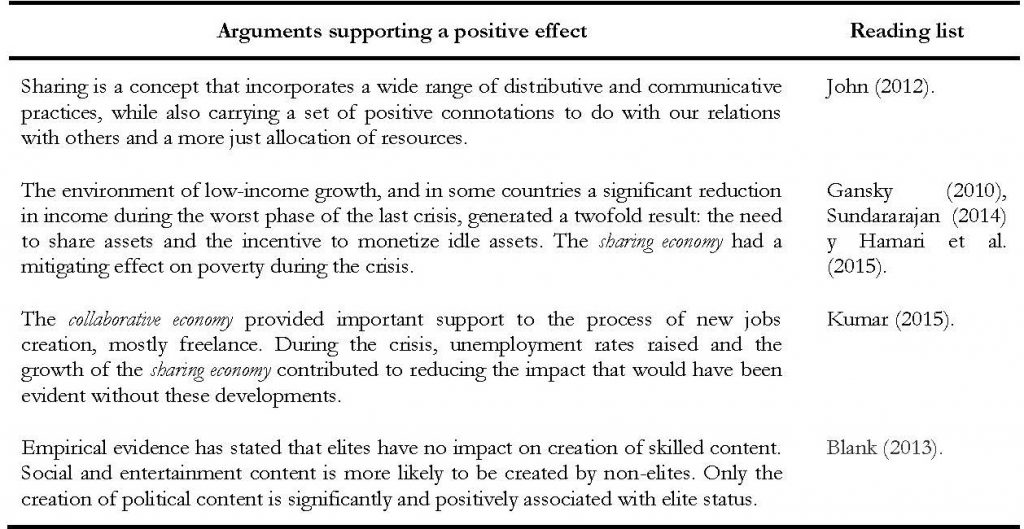 Source: Own elaboration.
Source: Own elaboration.
However, many commentators are of the view that the development of the collaborative economy will result in a more unfair society. In Table 7, some arguments supporting this negative effect are shown.Source: Own elaboration.
Table 7: An optimistic view of the collaborative economy on fairness level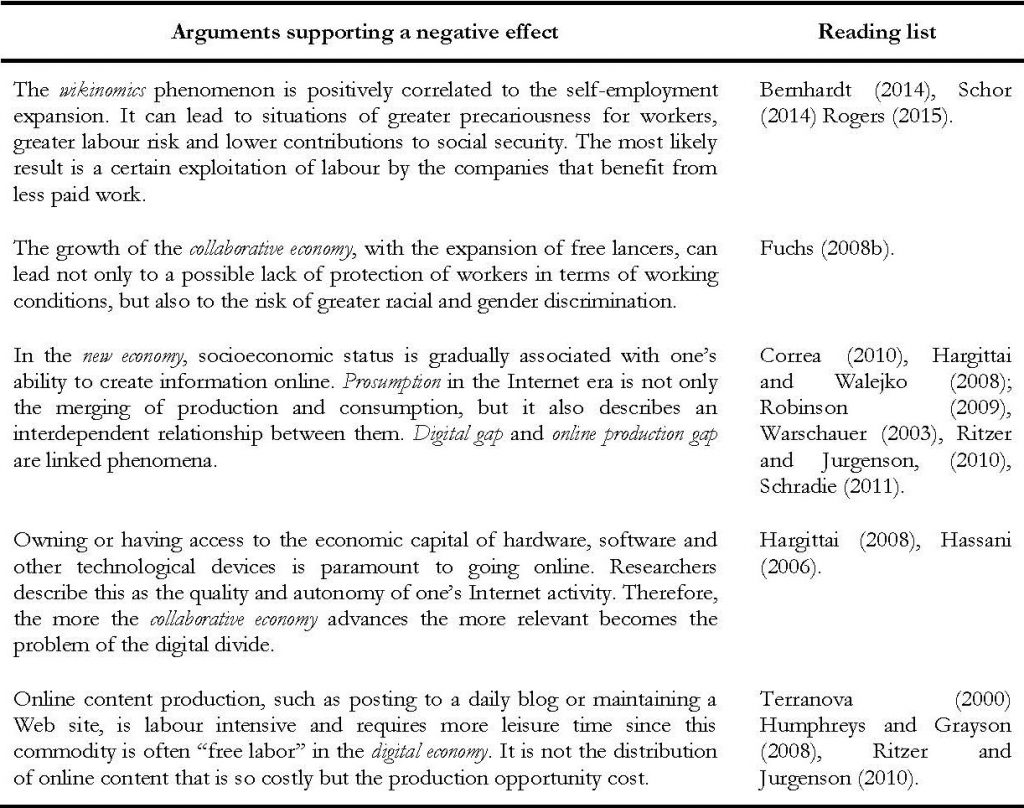 Source: Own elaboration.
Source: Own elaboration.
3.4. HOW DO ROBOTS AFFECT INEQUALITY
Computers are beginning to automate and make redundant plenty of jobs previously expected to remain in human control for a long time. The combination of artificial intelligence, big data, machine learning and mobile robotics imply that robots will be able to do almost every job. We face a world of driverless cars, drones for package delivery, computer programs to diagnose illnesses, and intelligent pattern recognition software that replaces lawyers, professors, doctors, journalists and others professionals. Robotics is already playing an important role in employment in the industrial and service sectors. Robots replacing humans has become one of the most discussed topics in research and business circles.[18]
It has been stated by some commentators that automated technology will be much more destructive of jobs than previous technological innovations. Cybernation or automation would result in an economy where potentially unlimited output can be achieved by systems of machines, which will require little cooperation from human beings.[19] Virtually every industry in existence is likely to become less labour-intensive. Machines are not only tools that increase the productivity of workers. Machines themselves are turning into workers. Technology will lead to a permanent, structural unemployment.[20] For some, the advance of robotics will result into not only higher unemployment, but also an additional step of redistributing income from work to capital. See Table 8.
Table 8: A pessimist view of the impact of robotization on fairness level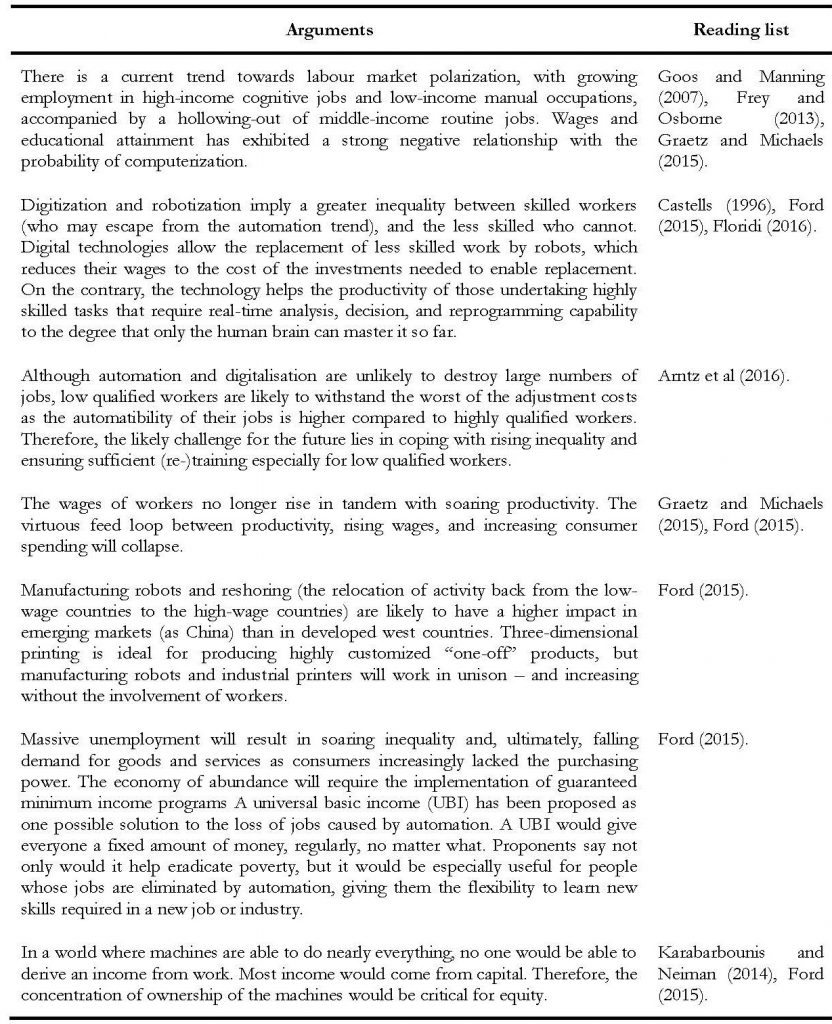 Source: Own elaboration.
Source: Own elaboration.
Robotics and artificial intelligence system will bring a wave of abundance. Even if automatization results in a higher level of unfairness, there will be a decrease of material poverty. Abundance of digital goods and services (including healthcare and education services), lowering of costs and increasing personalization will result in a raise of living standards for all individuals. Table 9 shows some arguments supporting an optimistic view of the impact of robots at work.Source: Own elaboration.
Table 9: Robotization will not result in a less fair society
Source: Own elaboration.
4. PUBLIC POLICY ISSUES
In this section, I propose some public policy issues to be addressed in connection to the role of the government in a scenario of digital revolution. See Table 10.
5. WHY TO USE THE SEMINAR METHOD?
There are at least two questions to answer in connection to the proposition of the four seminars that are discussed in this article. First, why to use the seminar method to address the topic of social fairness. Secondly, why to focus on the impact of the digital revolution when studying social inequality.
Regarding the first question, a seminar is a modern method of teaching and an advanced group technique of increasing use in higher education for a number of reasons. When it comes to discussing social fairness, all participants have an opinion to express, and the seminar method may give good motivation and learning experience to participants. The selection of these four topics enables between four and five groups of students and different discussants to participate in a session of 2 hours. See in table A1 in the appendix some instructions proposed for the seminar. Moreover, this method integrates reading and writing skills with presentation skills, which are of quite considerable benefit when compared with traditional lectures. In addition, the human interaction under this technique develops good manners and skills among the participants, and provides a good scholastic experience. The interactions in this method develop observation and questioning skills. Finally, this method inculcates responsibility and cooperative behaviours. See in Table A2 some recommendations and tips proposed to seminar’s participants.
The second question relates to the choice of the topic on how digital revolution may affect social inequality levels in a modern society. In public economics courses when it comes to discussing how egalitarian are contemporary societies, issues being tackled traditionally include, among others, inequality of income and social immobility, and how public policies may help to redress these situations. In the last century, taxes and inequality educational opportunity (IEO) have probably been the main drivers of both phenomena. In a digital economy, IEO remains crucial but new issues emerge. In particular, in the knowledge economy, issues as the inequality of access to new technologies, the power of workers in the virtual company, the role of free lancers in the collaborative economy, or the impact of robots and artificial intelligence on labour market become paramount. This is the main argument in support of the proposal included in this paper.
Appendix
Table A1: General seminar instructions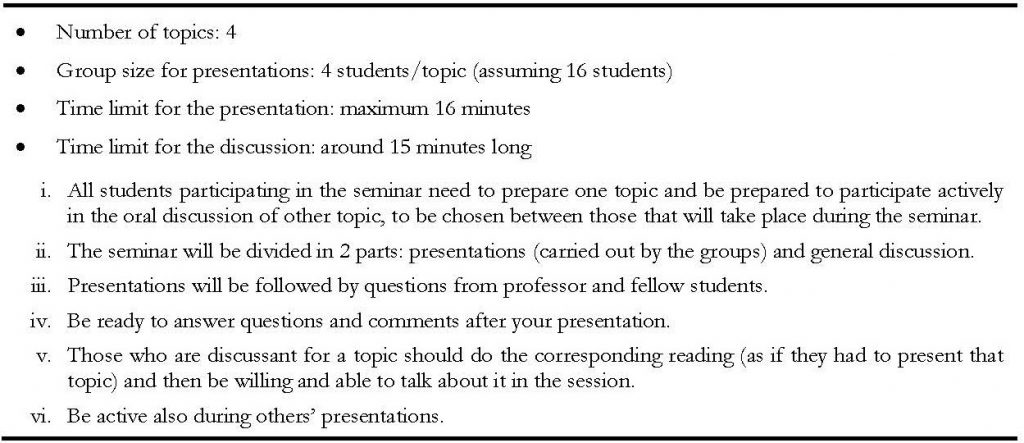
Table A2: Recommendations and tips
Notes
[1] See Howard et al. (2001).
[2] See Shapiro and Varian (2013).
[3] See Tapscott (1998) and Jones and Fox (2009).
[4] See Contreras (2017) for a non-advanced review of effects of the digital revolution on public economics analysis.
[5] See Webster, C. (1995) and Christensen. (1995).
[6] Véase Castells (1998).
[7] See Kiiski and Pohjola (2002) and Vicente and López (2011).
[8] See Yu (2002).
[9] See Mosaic Group (1998), Castells (2001), NTIA (1999), Rogers (2001), Norris (2001) or Kirkman et al. (2002).
[10] See Chen and Wellman (2004).
[11] See Kling (1998), Lessig (1999) O’Mahoney and Barley (1999), Wilson (2000), Bimber (2000), DiMaggio and Hargittai (2001), Fink and Kenny (2003), Hargittai (2003), DiMaggioet al. (2004), Barzilai-Nahon (2006) or Pearce and Rice (2013).
[12] See OECD (2001), Katz and Rice (2002) and Hilbert (2014)..
[13] See O'Reilly (2005).
[14] This phenomenon is also connected with concepts such as collaborative consumption, co-production, co-creation, or presumption.
[15] Véase Zelizer (2010).
[16] See Belk (2007) and Botsman and Rogers (2010).
[17] See Lamberton and Rose (2012).
[18] See Lukina et al. (2016).
[19] See Ford (2015).
[20] See Ford (2009 and 2015), Brynjolfsson and McAfee (2001)
References
Acemoglu, D. and Autor, D. (2011): “Skills, tasks and technology: Implications for employment and earnings” in Handbook of Labor Economics, Amsterdam: Elsevier.
Aladwani, A.M. (2003): “Key Internet characteristics and e-commerce issues in Arab countries”, Information Technology 16 (1).
Anderson, R. H, Bikson, T. K., Law, S. A. and Mitchell B.M. (1995): “Universal Access to E-Mail - Feasability and Societal Implications”, Santa Monica, CA: RAND.
Arntz, M., Gregory, T. and Zierahn, U. (2016): “The risk of automation for jobs in OECD countries: A comparative analysis”, OECD Social, Employment and Migration Working Papers, 189, OECD Publishing, Paris.
Arnum, E. and Conti, S. (1998): “Internet development worldwide: The new superhighway follows the old wires, rails, and roads”, Paper given at INET'98, July 21-24.
Autor, D.H. (2015): “Why Are There Still So Many Jobs? The History and Future of Workplace”, Journal of Economic Perspectives, 29(3): 3–30.
Autor, D.H. and Dorn, D. (2013): “How Technology Wrecks the Middle Class”, The New York Times, August 25: SR6-SR7.
Barzilai-Nahon, K. (2006): ‘‘Gaps and Bits: Conceptualizing Measurements for Digital Divide⁄s’’, The Information Society, 22: 269–78.
Beilock, R. and Dimitrova, D.V. (2003): “An Exploratory Model of Inter-Country Internet Diffusion", Telecommunications Policy 27: 237-252.
Belk, R. (2007): “Why Not Share Rather than Own?”, Annals of the American Academy of Political and Social Science, 611 (1): 126-140.
Benton Foundation (1998): Losing Ground Bit by Bit: Low-Income Communities in the Information Age. Washington DC: Benton Foundation and National Urban League.
Bernhardt, A. (2014): “Labor standards and the reorganization of work: Gaps in data and research”, eScholarship University of California, Working Paper Series.
Bessen, J.E. (2015): Learning by doing: the real connection between innovation, wages, and wealth. Yale University Press. New Haven and London.
Bessen J.E. (2016): “How computer automation affects occupations: Technology, jobs, and skills”, VOX CEPR's Policy Portal. 22 September.
Bimber, B. (2000): “The Gender Gap on the Internet”, Social Science Quarterly. 81 (3): 868-876
Blank, G. (2013): “Who creates content? Stratification and content creation on the Internet. Information”, Communication & Society, 16(4): 590-612.
Bonfadelli, H. (2002): “The Internet and Knowledge Gaps. A Theoretical and Empirical Investigation”, European Journal of Communication 17: 65–84.
Botsman, R. and Rogers, R. (2010): What’s Mine Is Yours: The Rise of Collaborative Consumption, New York: Harper Collins.
Brewer, J. (2013): Executive Order 2012-03, “State Regulatory Review, Moratorium and Streamlining to Promote Job Creation and Retention.”, Arizona Administrative Register 19(35): 2764-65.
Brynjolfsson, E. and McAfee, A. (2011): Race Against The Machine: How The Digital Revolution Is Accelerating Innovation, Driving Productivity, and Irreversibly Transforming Employment and The Economy, eBooks.
Brynjolfsson, E. and McAfee, A. (2014): The second machine age: Work, progress, and prosperity in a time of brilliant technologies, New York, NY: WW Norton & Company.
Carveth, R. and Kretchmer, S. B. (2002): “The digital divide in Western Europe: problems and prospects”, Informing Science.
Castells. M. (1996): The information age: Economy, society and culture” Vol I: The rise of network society. Blackwell Publishers Inc. Cambridge, Massachusetts.
Castells. M. (1998): The information age: Economy, society and culture” Vol III: End of millennium. Blackwell Publishers Inc. Cambridge, Massachusetts.
Castells. M. (2001): The Internet Galaxy. Oxford University Press.
Cha, H. S., Durcikova, A., and McCoy, S. (2005): “Modeling Internet diffusion in developing countries”. AMCIS 2005 Proceedings, 259.
Chen, W. and Wellman, B. (2004): “The global digital divide–within and between countries”, IT & society, 1(7): 39-45.
Chinn, M. D. and Fairlie, R. W. (2007): “The determinants of the global digital divide: a cross-country analysis of computer and internet penetration”, Oxford Economic Papers, 59(1): 16-44.
Christensen, D. (1995): “The World Wide Web: the Great Equalizer”, Online: http.//webz.com/theweb/
Cohen, S., Mermelstein, R., Kamarck, T., and Hoberman, H. (1984): “Measuring the functional components of social support”, in Sarason, I.G. y Sarason, B. R. (Eds.), Social support: Theory, research and applications, The Hague, Holland: Martines Niijhoff: 73-94.
Cohen, S. and Wills, T. A. (1985): “Stress, social support, and the buffering hypothesis”, Psychological Bulletin, 98(2), 310.
Compaine, B. (2001): Re-examining the digital divide. Communications Policy in Transition: The Internet and Beyond. MIT Press, Cambridge, MA.
Contreras, C. (2017): El papel del gobierno en la era digital: un enfoque de economía pública. Editorial Universitaria Ramón Areces, Madrid.
Correa, T. (2010): “The participation divide among online experts”, Journal of Computer-Mediated Communication, 16 (1): 71–92.
Cullen, R. (2001): “Addressing the digital divide”, Online information Review, 25(5): 311-320.
Cummings, J. N., Butler, B., and Kraut, R. (2002): “The quality of online social relationships”, Communications of the ACM, 45(7): 103-108.
Dasgupta, S., Lall, S. and Wheeler, D. (2001): “Policy reform, economic growth, and the digital divide: An econometric analysis”, World Bank Publications, 2567.
DiMaggio, P. and Hargittai, E. (2001): “From the ‘digital divide’to ‘digital inequality’: Studying Internet use as penetration increases”, Princeton: Center for Arts and Cultural Policy Studies, Woodrow Wilson School, Princeton University, 4(1): 4-2.
DiMaggio, P., Hargittai, E. Celeste, C. y Shafer, E. (2004): ‘‘Digital Inequality: From Unequal Access to Differentiated Use”, in Social Inequality, edited by Kathryn Neckerman, K., New York: Russell Sage Foundation: 355–400.
Du, X. (1999): “Internet Diffusion and Usage in China”, Prometheus, 17 (4).
Dubrovsky, V. J., Kiesler, S., and Sethna, B. N. (1991): “The equalization phenomenon: Status effects in computer-mediated and face-to-face decision-making groups”, Human-computer interaction, 6(2), 119-146.
Ebo, B. L. (1998): Cyberghetto or cybertopia?: race, class, and gender on the Internet. Greenwood Publishing Group Inc.
Economist (2004): “Survey: Outsourcing: A World of Work,” The Economist, November 11
Engelman, L.J. (1995): “The great equalizer” http://www.iw.com//1995/07/foundit.htm
Fink, C. and Kenny, C. J. (2003): “W(h)ither the digital divide?” Info, 5(6), 15-24.
Fjermestad, J. and Saitta, J. A. (2005): “A Strategic Management Framework for IT Outsourcing: A Review of the Literature and the Development of a Success Factors Model”, Journal of Information Technology Case and Application Research, 7 (3): 42-60.
Fletcher, A. (1998): “Markets and states in the information society: a comparative institutional analysis of telecommunications policy in the United States and France”, Political Communication, July-Sep V15N3:413(2).
Floridi, L. (2016): “Human have nothing to fear from intelligent machines”, Financial Times.
Ford, M. (2009): The Lights in the Tunnel. Lexington, KY: Acculant Publishing.
Ford, M. (2015): Rise of the robots: technology and the threat of a jobless future Basic Books, New York
Frank, M., Roehrig, P. and Pring, B. (2017): What to do when machines do everything. John Wiley & Sons, New Jersey.
Freeman, C. and Louçã, F. (2002): As Time Goes By: From the Industrial Revolutions to the Information Revolution. Oxford University Press, USA.
Frey, C. B. and Osborne, M. A. (2013): “The future of employment: how susceptible are jobs to computerisation?,” Sept, 17, mimeo.
Friedman, T. L. (2005a): The world is flat: A brief history of the twenty-first century. New York: Farrar, Straus and Giroux.
Friedman, T. L. (2005b): “It's a flat world, after all, The New York Times, 3: 33-37.
Fuchs, C. (2008a): “The role of income inequality in a multivariate cross-national analysis of the digital divide”, Social Science Computer Review.
Fuchs, C. (2008b): “Review-Wikinomics: How mass collaboration changes everything”. Journal of Communication, 58(2): 402-403.
Gansky, L. (2010): The mesh: Why the future of business is sharing. Penguin.
Gefen, D. and Carmel, E. (2008): “Is the world really flat? A look at offshoring at an online programming marketplace”, MIS Quarterly: 367-384.
Giussani, B. (1997): “France Gets Along With Pre-Web Technology”, The New York Times CyberTimes, September 23.
Golding, P. (1998): “Worldwide Wedge. Divisions and Contradictions in the Global Information Infrastructure”: 135–48 in D. K. Thussu (ed.) Electronic Empires. London: Arnold.
Goldin, C. and Katz, L.F (2009): The Race between Education and Technology. The Belknap Press of Harvard University Press.
Goodman, S.E., Press, L.I., Ruth, S.R., and Rutkowski, A.M. (1994): “The Global Diffusion of the Internet: Patterns and Problems”, Communications of the ACM, 37 (8): 27-3.
Graetz, G and Michaels, G. (2015): “Robots at Work”, Center for Eeconomic Performance Discussion Paper, 1335.
Hamari, J., Sjöklint, M., and Ukkonen, A. (2015): “The sharing economy: Why people participate in collaborative consumption”, Journal of the Association for Information Science and Technology, 67 (9): 2047–2059.
Hargittai, E. (1999): "Weaving the Western Web: Explaining differences in Internet connectivity among OECD countries", Telecommunications Policy 23: 701-718.
Hargittai, E. (2003): How Wide a Web? Inequalities in Accessing Information Online, Princeton, NJ: Sociology Department, Princeton University.
Hargittai, E. (2008) in: Grusky, D. (Ed.) The Digital Reproduction of Inequality. Social Stratification. Westview Press, Boulder, CO: 936–944.
Hargittai, E. (2008): “Digital Na(t)ives? Variation in Internet Skills and Uses among Members of the Net Generation”, Sociological inquiry, 80(1): 92–113,
Hargittai, E. and Hinnant, A. (2008): “Digital inequality differences in young adults' use of the Internet”, Communication Research, 35(5), 602-621.
Hargittai, E. and Walejko, G. (2008): “The participation divide: content creation and sharing in the digital age 1”, Information, Community and Society, 11(2):239-256.
Hassani, S.N. (2006): “Locating digital divides at home, work and everywhere else”, Poetics 34 (4–5): 250–272.
Hauben, M. and Hauben, R. (1997): Netizens: on the history and impact of Usenet and the Internet, Los Alamitos, California: IEEE Computer Society Press,
Helsper, E. J. (2010): “Gendered internet use across generations and life stages”, Communication Research, 37(3): 352-374.
Hilbert, M. (2011): “The end justifies the definition: The manifold outlooks on the digital divide and their practical usefulness for policy-making”, Telecommunications Policy, 35 (8): 715-736.
Hilbert, M. (2014): “Technological information inequality as an incessantly moving target: The redistribution of information and communication capacities between 1986 and 2010”, Journal of the Association for Information Science and Technology, 65 (4): 821-835.
Hilbert, M. (2016): “The bad news is that the digital access divide is here to stay: Domestically installed bandwidths among 172 countries for 1986-2014”, Telecommunications Policy, 40 (6): 567-581.
Hoffman, D. L., and Novak, T. P. (1998): “Bridging the Digital Divide: The Impact of Race on Computer Access and Internet Use”, mimeo.
Howard, P. N., Rainie, L. y Jones, S. (2001): “ays and Nights on the Internet: The Impact of a Diffusing Technology”, American Behavioral Scientist, 45:383–404.
Huang, H, Keser, C, Leland, J and Schachat, J. (2003): “Trust, the Internet, and the digital divide”, IBM System Journal, 42(3): 507-518.
Humphreys, A., and Grayson, K. (2008): “The intersecting roles of consumer and producer”, Sociology Compass 2 (3): 963–980.
Ivanova, I., Arcelus, F.J. and Srinivasan, G. (1999): “An assessment of the measurement properties of the human development index”, Social Indicators Research, 46: 157-179.
Jackson, L. A., Ervin, K. S., Gardner, P. D., and Schmitt, N. (2001): “The racial digital divide: Motivational, affective, and cognitive correlates of Internet use”, Journal of Applied Social Psychology, 31(10), 2019-2046.
John, N. A. (2012): “Sharing and Web 2.0: The emergence of a keyword”, New Media & Society, 15(2): 167–182.
Jones, S. and Fox, S. (2009): Generations Online in 2009. Washington, DC: Pew Internet & American Life Project.
Joy, B. (2000): “Why the future doesn’t need us”, Wired, 8.04.
Karabarbounis, L. and Neiman, B (2014): “The global decline of the labor share”, The Quarterly Journal of Economics, 61: 103.
Katz, J. E. and Rice, R. E. (2002): Social consequences of Internet use: access, involvement, and interaction. MIT Press.
Kelly, T. and Petrazzini, B. (1997): “What Does The Internet Mean For Development?” Telecom Interactive Development Symposium. Geneva. September 11.
Kiesler, S.and Sproull, L. (1992): “Group decision making and communication technology”, Organizational behavior and human decision processes, 52(1), 96-123.
Kiiski, S. and Pohjola, M. (2002): “Cross-Country Diffusion of the Internet”, Information Economics and Policy 14:297-310.
Kirkman, G. S., Cornelius, P. K., Sachs J. D. and Schwab K. (eds) (2002): Global Information Technology Report 2007-2002, Oxford University Press.
Kling, R. (1998): “Technological and Social Access on Computing, Information and Communication Technologies”, White Paper for Presidential Advisory Committee on High-Performance Computing and Communications, Information Technology, and the Next Generation Internet.
Kraut, R. E., Patterson, M., Lundmark, V., Kiesler, S., Mukhopadhyay, T. and Scherlis, W. (1998): “Internet paradox: A social technology that reduces social involvement and psychological well-being?”, American Psychologist, 53 (9): 1017-1032.
Kumar, S. (2015): “3 reasons to cheer Uber and the sharing economy”, available at http://fortune.com/2015/07/20/uber-and-the-sharing-economy.
Lamberton, C.P. and Rose, R.L. (2012): “When Is Ours Better Than Mine? A Framework for Understanding and Altering Participation in Commercial Sharing Systems”, Journal of Marketing, 76: 109–125.
Leamer, E. E. (2007): “A Flat World, a Level Playing Field, a Small World after All, or None of the above? A Review of Thomas L. Friedman's ‘The World is Flat’", Journal of Economic Literature: 83-126.
Lee, H., O'Keefe, R. M. and Yun, K. (2003): “The growth of broadband and electronic commerce in South Korea: contributing factors”, The Information Society, 19(1): 81-93.
Lessig, L. (1999): Code and Other Laws of Cyberspace, New York: Basic Books
Levy and Murnane (2004): The new division of labor: How computers are creating the next job market. Princeton, NJ: Princeton University Press
Livingstone, S., and Helsper, E. (2007): “Gradations in digital inclusion: children, young people and the digital divide. New Media & Society, 9(4): 671-696.
Loges, W. E. and Jung, J. Y. (2001): “Exploring the digital divide internet connectedness and age, Communication Research, 28(4): 536-562.
OECD (2001): Understanding the Digital Divide (OECD Digital Economy Papers). Paris: OECD, D. for S, T & I.
Petrovna Lukina, N. P., Slobodskaia, A.V. and Zilberman, N.N. (2016): “Social dimensions of labour robotization in post-industrial society: issues and solutions”, Man In India, 96 (7): 2367-2380.
Marchant, G. E., Stevens, Y.S. and Hennessy, J.M. (2014): “Technology, Unemployment & Policy Options: Navigating the Transition to a Better World”, Journal of Evolution and Technology, 24(1): 26-44.
Marin, D. (2014): “Globalisation and the rise of the robots” VOX CEPR's Policy Portal, 15 November.
McKenna, K.Y.A. and Bargh, J. A. (1998): “Coming out in the age of the Internet: Identity ‘demarginalization’ through virtual group participation”, Journal of Personality and Social Psychology, 75: 681-694.
McKenna, K.Y.A. and Bargh, J. A. (2000): “Plan 9 from cyberspace: The implications of the Internet for personality and social psychology”, Personality and Social Psychology Review, 4: 57-75.
Madon, S. (2000): “The Internet and socio-economic development: exploring the interaction”, Information Technology & People, 13 (2): 85-101.
Maitland, C. F. and Bauer, J. M. (2001): “National Level Culture and Global Diffusion: The Case of the Internet”, Culture, Technology, Communication: Towards an Intercultural Global Village. C. Ess, editor. State University of New York Press: 87-128.
Milner, H. V. (2006): “The Digital Divide The Role of Political Institutions in Technology Diffusion”, Comparative Political Studies, 39(2): 176-199.
Montagnier, P. and Wirthmann, A. (2011): Digital Divide: From computer access to online activities–A micro data analysis, OECD, France and Eurostat, Luxemburg.
Mosaic Group (1998): The Global Diffusion of the Internet Project: An Initial Inductive Study, www,agsd.com/gdi97/gdi97.html.
Mutula, S.M. (2002): Current developments in the Internet industry in Botswana, The Electronic Library 20 (6): 504-511.
Negroponte, N. (1995): Being Digital. Knopf.
Nix, J. V. and BlairLoy, M. (2000): “Cyberstratification and Social Distance over the Internet: Using the Bogardus Scale to Measure Prejudice among WWW users”, mimeo.
Norris, P. (2001): Digital Divide: Civic Engagement, Information Poverty, and the Internet Worldwide. Cambridge University Press.
Notten, N., Peter, J., Kraaykamp, G., and Valkenburg, P. M. (2009): “Research note: digital divide across borders—a cross-national study of adolescents’ use of digital technologies”, European Sociological Review, 25(5), 551-560.
Novak, T. P. and Hoffman, D.L. (1998): “Bridging the Digital Divide: The Impact of Race on Computer Access and Internet Use” Science.
NTIA (National Telecommunications and Information Administration) (1995): Falling Through the Net: A Survey of the “Have Nots” in Rural and Urban America. July. U.S. Department of Commerce. Washington, DC.
NTIA (National Telecommunications and Information Administration) (1999): Falling Through the Net III: Defining the Digital Divide, Washington, D.C.: U.S. Department of Commerce
NUA Internet Surveys (2001): “How Many Online?”
OECD (1996): Information Infrastructure Convergence and Pricing: The Internet. Paris: OECD. http://www.oecd.org/dsti/sti/it/cm/prod/e_96-73.htm.
O’Mahony S. and Barley S.R. (1999): “Do digital telecommunications affect work and organization? The state of our knowledge”, Research in Organizational Behavior 21: 125-61.
Ono, H. and Zavodny, M. (2003): “Gender and the Internet”, Social Science Quarterly 84:111–21.
Ono, H. and Zavodny, M. (2007): “Digital inequality: A five country comparison using microdata”, Social Science Research, 36 (3):1135-1155
O'Reilly, T. (2005): “What Is Web 2.0”. O'Reilly Network.
Paltridge, S. (1996): “How competition helps the Internet”, The OECD Observer, 201: 25(4)
Paltridge, S. and Ypsilanti, D. (1997): “A Bright Outlook for Communications”, The OECD Observer, 205: 19-22.
Pearce, K. E. and Rice, R. E. (2013): “Digital divides from access to activities: comparing mobile and personal computer internet users”, Journal of Communication, 63(4), 721-744.
Prensky, M. (2001): “Digital Natives, Digital Immigrants”, On the Horizon, 9: 1–6.
Press, L. (1997): “Tracking the global diffusion of the Internet”, Communications of the ACM, (40):11.
Petrazzini, B., and Kibati, M. (1999): “The Internet in Developing Countries”, Communications of the ACM, 42 (6): 31-36.
Polly, J. A., and Polly, J. A. (1993): Surfing the Internet, Project Gutenberg.
Quibria, M. G., Ahmed, S. N., Tschang, T. and Reyes-Macasaquit, M. L. (2003): “Digital divide: Determinants and policies with special reference to Asia”, Journal of Asian Economics, 13(6), 811-825.
Ritzer, G. and Jurgenson, N. (2010): “Production, consumption, presumption”, Journal of Consumer Culture 10: 13–36.
Robinson, L, (2009): “A taste for the necessary”, Information, Communication and Society 12 (4): 488.
Robinson, J., Barth, K. and Kohut, A. (1997): “Peronsal Computers, Mass Media, and Use of Time”, Social Science Computer Review, 15: 65-82.
Robinson, J., Levin, S. and Hak, B. (1998): “Computer Time”, American Demographics. August: 18-23.
Robinson, J. P., DiMaggio, P., and Hargittai, E. (2003): “New social survey perspectives on the digital divide”, It & Society, 1(5), 1-22.
Rogers, E. M. (2001): “The Digital Divide”, Convergence, 7(4): 96-111.
Rogers, B. (2015): “The social costs of Uber”, University of Chicago Law Review Dialogue. Temple University Legal Studies Research Paper 15/28.
Sachs, J.D. and Kotlikoff, L.J. (2012): “Smart Machines and Long-Term Misery.” NBER Working Paper, 18629.
Sciadas, G. (2002): “Unveiling the digital divide”, mimeo.
Schor, J. (2014): Debating the sharing economy. Great Transition Initiative: Toward a Transformative Vision and Praxis: 1-13.
Schradie, J. (2011): “The digital production gap: The digital divide and Web 2.0 collide”, Poetics, 39(2), 145-168.
Selwyn, N. (2004): “Reconsidering Political and Popular Understandings of the Digital Divide”, New Media & Society 6: 341–62.
Shapiro, C and Varian, H.R. (1998): Information Rules: A Strategic Guide to the Network Economy. Harvard Business School Press.
Spence, M. and S. Hlatshwayo (2011): “The Evolving Structure of the American Economy and the Employment Challenge”, Council of Foreign Relations Working Paper. March.
Sproull, L. and Kiesler, S. (1991): Connections: New ways of working in the networked organization. Cambridge, MA: MIT Press.
Sundararajan, A. (2014): “Peer-to-peer businesses and the sharing (collaborative) economy: Overview, economic effects and regulatory issues”, Written testimony for the hearing titled The Power of Connection: Peer to Peer Businesses.
Tapscott, D. (1996): The Digital Economy: Promise and Peril in the Age of Networked Intelligence. New York: McGraw-Hill.
Tapscott, D. and Caston, A. (1993): Paradigm Shift The New Promise of Information Technology, McGraw-Hill.
Tapscott, D. (1998): Growing Up Digital: The Rise of the Net Generation, New York: McGraw Hill.
Tracy, A. (2013): “The ’40 Hours a Week or Less’ Theory Gains Momentum.”Inc. Magazine, October 10.
Terranova, T. (2000): “Free labor”, Social Text 18 (2): 33–58.
Van Dijk, J. (2005): The Deepening Divide: Inequality in the Information Society, Sage Publications.
Van Dijk, J. and Hacker, K. (2003): “The digital divide as a complex and dynamic phenomenon”, The information society: an International Journal, 19 (4): 315-326.
Vicente, M. R., and López, A. J. (2011): “Assessing the regional digital divide across the European Union-27”, Telecommunications Policy, 35(3), 220-237.
Volken, T. (2002): “Elements of Trust: The Cultural Dimension of Internet Diffusion Revisited”, Electronic Journal of Sociology 6 (4).
Warschauer, M. (2003): Technology and Social Inclusion. MIT Press, Cambridge, MA.
Webster, C. (1995): “The world wide web: The great equalizer of the Internet”, mimeo.
Weia, L. and Hindmanb, D.B (2011): “Does the Digital Divide Matter More? Comparing the Effects of New Media and Old Media Use on the Education-Based Knowledge Gap”. Mass Communication and Society,14 (2): 216-235.
Wellman, B., Quan, A., Witte, J. and Hampton, K. (2001): “Does the Internet Increase, Decrease or Supplement Social Capital?: Social Networks, Participation, and Community Commitment”, American Behavioral Scientist 45.
Westerman, G., Alhammadi, Y. and Brynjolfsson, E. (2014): “Racing with and against the machine: changes in occupational skill composition in an era of rapid technological advance”, Thirty Fifth International Conference on Information Systems, Auckland.
Wilson E.J. (2000): “Closing the Digital Divide: An Initial Review”, Briefing the President. Washington: The Internet Policy Institute.
Witte, J. and Mannon, S. (2010): The Internet and Social Inequalities. Routledge, New York, NY.
Wojahn, P. G. (1994): “Computer-mediated communication: The great equalizer between men and women?, Technical Communication, 747-752.
Wolf, A. (1998): “Exposing the great equalizer” in Demythologizing Internet equity. Cyberghetto or cybertopia: 15-32.
Wolk, R. M. (2004): “The effects of English language dominance of the Internet and the digital divide.” Technology and Society, 2004. ISTAS'04. International Symposium on IEEE: 174-178.
Yglesias, M. (2013): “New Jersey’s Insane Ban on Self-Service Gasoline.” Slate.com, Sept. 18, 2013, accessed September 22.
Yu, P. K. (2002): Bridging the digital divide: Equality in the information age. Cardozo Arts & Ent. LJ, 20, 1.
Zelizer, V. A. (2010): Economic lives: How culture shapes the economy. Princeton University Press.
Zhang, C., Callegaro, M. and Thomas, M. (2008): ‘‘More than the Digital Divide?: Investigating the Differences between Internet and Non-Internet Users.’’ in Midwest Association of Public Opinion Research. Chicago, IL.
Zhao, H. (2002): “Rapid Internet Development in China: A Discussion of Opportunities and Constraints on Future Growth”, Thunderbird International Business Review, 44 (1): 119-138.
Zhu, J.J.H. and He, Z. (2002): “Perceived Characteristics, perceived needs, and perceived popularity: Adoption and Use of the Internet in China”, Communication Research, 29, 4.
Zillien, N. and Hargittai, E. (2009): “Digital Distinction: Status-Specific Types of Internet”, Social Science Quarterly, 90 (2): 274–291.
